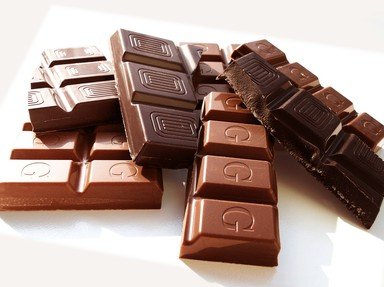Quiz Answer Key and Fun Facts
1. Every piece of chocolate begins with pods on a plant called Theobroma cacao. What kind of plant is this?
2. When a cacao pod is ripe, the farmer can harvest it, open it, and remove cocoa beans covered in a white, pulpy fruit. But the farmer's job isn't done: it's now time to pop the beans, fruit and all, into hot sweatboxes. What's happening to the beans?
3. Chocolate-making truly heats up once the cocoa beans are in the roaster! Which of these statements about the roasting process is true?
4. Cocoa beans don't last long after roasting: the very next step is to crush them into tiny fragments. What are these little pieces, which will eventually become chocolate, called?
5. At this stage, we have little bits of cocoa bean, but they would make a chocolate bar unpleasantly lumpy. So, the next stage is to mill them -- that is, to grind them finer and finer, just like a flour mill. It isn't chocolate flour that comes out, though. What is the final product of all this grinding?
6. We're finally ready to mix some other ingredients in with our chocolate. At the mixing stage, we introduce sugar at last, so things are looking up. And to make particularly tasty chocolate, it's necessary to add some extra fat. Which of these do chocolatiers commonly add at this stage?
7. The initial mixing stage isn't perfect; the resulting chocolate can be a little grainy, and doesn't taste quite right. It's time for another machine! This one, invented by Rodolphe Lindt in 1879, grinds and agitates the chocolate mix -- perhaps for days. What is this process called?
8. The final step in chocolate making is to optimize the crystal structure in a process called tempering. Which of these features is characteristic of poorly tempered chocolate?
9. At last, the chocolate mixture is done! We just have to serve it, ready to eat. To make a chocolate bar, you can pour the chocolate mixture into a bar-shaped mold and let it cool there. Molds are also used to make hollow chocolates -- like Easter eggs or Valentine hearts. If there isn't a drainage hole in the finished candy, how did the chocolatier get the chocolate to coat all the sides of the mold?
10. We now know how to make chocolate -- dark or milk chocolate, that is. I know many people who would be content to stop there, but we haven't talked about white chocolate at all! How is white chocolate different from milk chocolate?
Source: Author
CellarDoor
This quiz was reviewed by FunTrivia editor
WesleyCrusher before going online.
Any errors found in FunTrivia content are routinely corrected through our feedback system.

